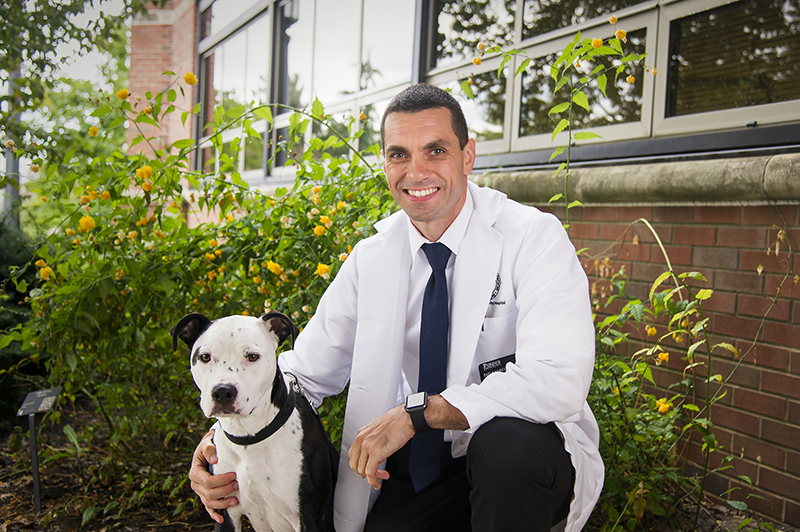September 21, 2016
Purdue Profiles: Paulo Gomes
 Dr. Paulo Gomes, clinical assistant professor of veterinary dermatology. (Purdue University photo/Rebecca Wilcox)
Download image
Dr. Paulo Gomes, clinical assistant professor of veterinary dermatology. (Purdue University photo/Rebecca Wilcox)
Download image
Dr. Paulo Gomes is a clinical assistant professor of veterinary dermatology in Purdue's College of Veterinary Medicine. He has been at Purdue for two and a half years and is a clinician in both the small and large animal hospitals, teaches veterinary dermatology and contributes with research.
He graduated from São Paulo State University in Brazil as a veterinarian and completed his dermatology training at the University of Minnesota. Dr. Gomes is a board certified dermatologist by the American College of Veterinary Dermatology.
Why did you choose a focus in veterinary dermatology?
I think the skin is a wonderful organ. It is the biggest organ in the organism. It’s fascinating. It has an important immunological role, and structurally it is vital to maintain the homeostasis of the organism. Basically, it is the barrier between the organism and the environment. In addition, veterinary dermatology has the highest case load in the small animal practice. At least 50 percent of the cases seen in small animal practice are primary dermatology issues or have dermatology issues associated with a different underlying cause.
What do your day-to-day duties look like as a clinical assistant professor of dermatology in the College of Veterinary Medicine?
We receive cases at Purdue University Veterinary Teaching Hospital on a daily basis. We have students with us to assist in the receiving of our patients, therefore they have the opportunity to actively learn from every step involved in this process. Depending of the specifics of each case we may perform a wide array of diagnostic tests until we reach a definitive diagnosis. Our teaching responsibilities include clinical, didactic, and laboratory instruction of professional veterinary students, veterinary technician students, graduate students, interns, and residents. We provide consultations to local veterinarians, so if they have a challenging case they can reach out to us for some assistance. We also contribute with other investigators in research projects and we are engaged in departmental activities. In addition I am currently a member of the board of directors for the West Central Indiana Veterinary Medical Association. This association organizes and delivers continuing education lectures for veterinarians in our area.
What is a particularly memorable case that you’ve had?
We treated a 12-year-old spayed female mixed breed dog that had suffered from allergies for the past 10 years. Her allergies were not well-controlled for many years and she had significant side effects of past treatments. When she came to us, she was the first dog we had on a brand-new treatment for atopic dermatitis (environmental allergy). Since we started her on monthly injections of this medication, her allergy has been well-controlled and she stopped being an itchy dog. Unfortunately, she had other health issues and is no longer with us, but we were able to give her some comfort and relief from her allergies towards the end of her life. Her family was very pleased with the treatment we provided for her, and at this point we have several patients on this same medication with a great success rate.
What do you do in your free time?
I like to be physically active, so I exercise four to five times per week. I play the guitar in my free time and in the church’s band on Sundays. Every time that there is a concert or some event in town, in Indianapolis or Chicago, I tend to go. Those are things that I do outside the veterinary world, but of course I still do some studying in my free time too.
What is your favorite part of your job?
I love it all. I think my favorite is teaching. Being able to be a professor and a clinician at the same time is the perfect combination for me. It’s the two things that I enjoy. I also like being around students because they always come with great questions and they are always challenging you, so it’s a way that you keep young at heart. It’s also a constant stimulus for you to improve.
What do you hope to instill in your students?
I hope to instill a sense of purpose about why it's important to learn dermatology. They will be using dermatology knowledge on a daily basis and if they are able to understand and be confident about what they’re doing, how to perform and interpret diagnostic tests, and how to treat their patients accordingly my goal is accomplished. I also want them to never stop learning. If you choose to be in veterinary medicine, it’s a commitment for life. You will have to be up to date on publications and new information regarding treatment and diagnostic techniques. If they have this purpose in mind about how important dermatology is in the small animal practice, and if they have perseverance, in time they will accomplish many things.
Writer: Kelsey Schnieders, 574-933-4413, kschnied@purdue.edu

